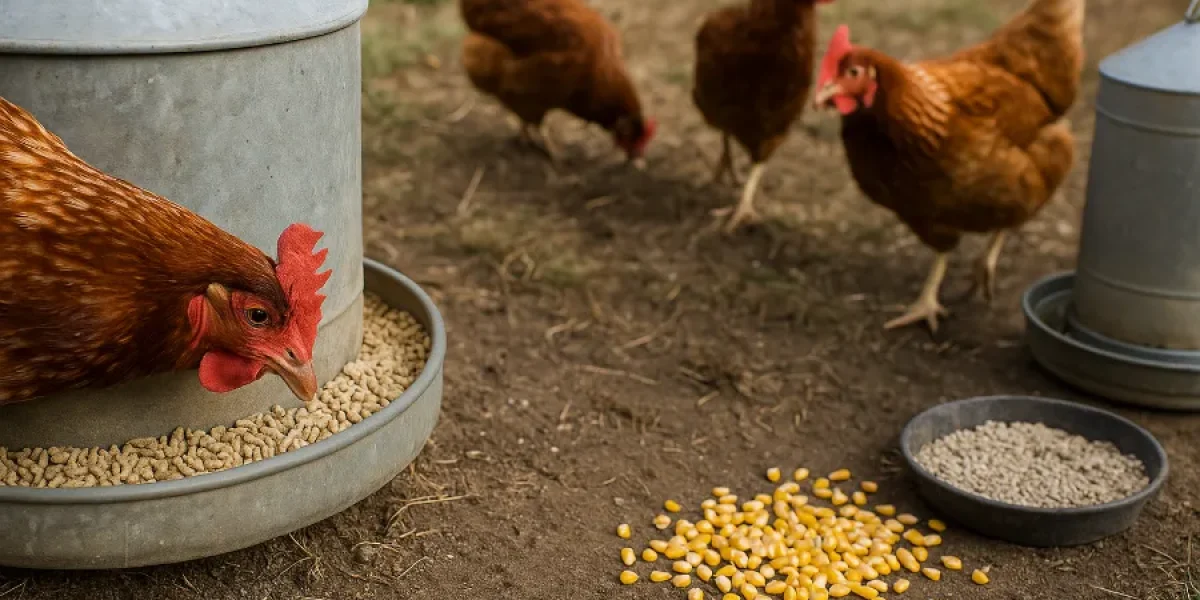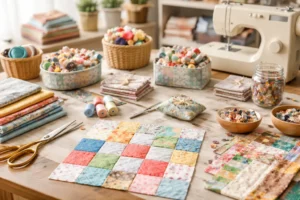When I brought home my first flock, I figured a scoop of something labeled “chicken feed” was all they needed. I couldn’t have been more wrong. Over the years, I’ve realized that choosing the right chicken feed isn’t just about filling a feeder — it’s about balancing nutrition, budget, and flock health.
Every scoop determines how your hens grow, lay, and live. Whether you’re a backyard keeper with six hens or managing a small homestead flock, understanding chicken feed can turn your coop from “hit-or-miss” to consistently productive.
Let’s walk through the feeds, styles, and systems that have worked for me (and what hasn’t).
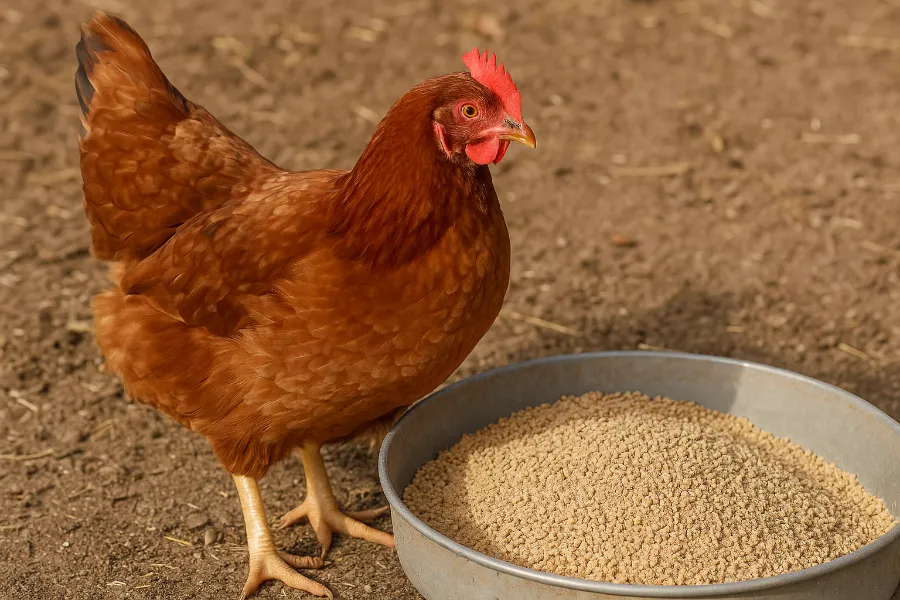
Laying Hens
When you think of laying hens, think of tiny athletes. Each one creates a complete egg nearly every day — shell, yolk, and all — from what she eats.
On average, a laying hen eats 4 to 6 ounces of feed per day (around ¼ to ⅓ pound). Smaller breeds like Leghorns need less, while heavier girls like Orpingtons or Rhode Island Reds need more.
If you want strong shells and rich yolks, nutrition must be steady. My hens start the morning with their main ration and spend the afternoon scratching through pasture or compost piles. That mix of routine and exploration keeps them healthy and calm — and yes, it shows up in the egg basket.
Layer Feed
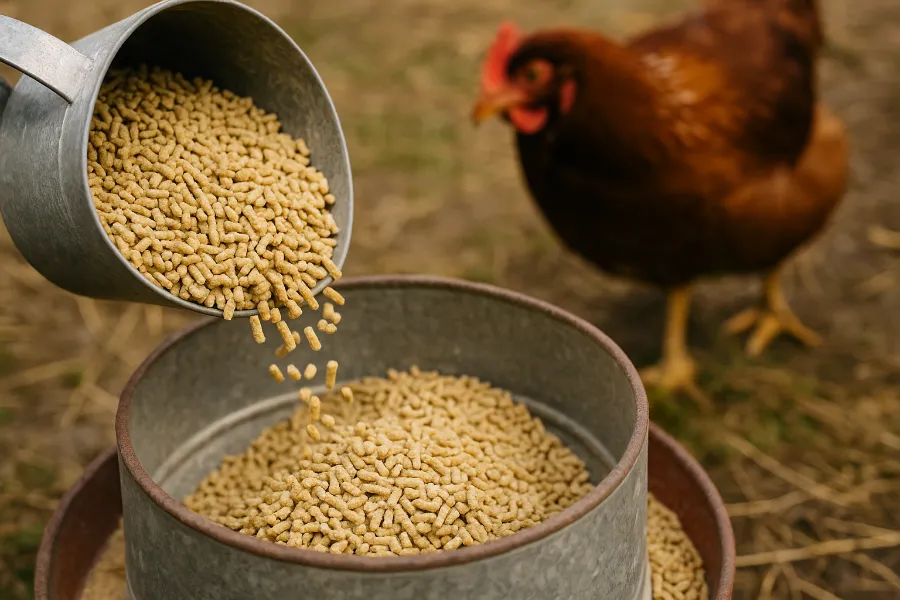
After trying countless blends, I’ve learned that good layer feed is non-negotiable. This is the complete ration made for hens that are 18 weeks or older and actively laying.
My favorite kinds of layer feed:
- Pellets: Less waste, easy to scoop, and hens can’t pick out favorites.
- Crumbles: Smaller bits, perfect for younger layers transitioning to adult feed.
- Mash: A fine, powdery blend that can be fed dry or mixed with warm water into a “porridge” during winter.
Each contains around 16–18% protein and about 3.5–4% calcium. Those two numbers matter — protein fuels egg production, and calcium keeps shells from cracking.
For anyone just starting out: skip the guesswork and buy a complete layer feed first. You can always experiment with scratch grains or fermented feed later.
Egg Production
I can always tell when my hens aren’t eating enough or the balance is off egg production drops.
Low protein leads to smaller eggs.
Low calcium makes shells thin or soft.
Too many treats or scratch grains can dilute the nutrients in their main feed.
My rules for consistent egg production:
- Feed the right ration daily. Never alternate between layer and grower feeds once laying starts.
- Offer free-choice oyster shell. It’s the easiest calcium source.
- Keep clean water available 24/7. Even slight dehydration slows laying.
- Add occasional supplements. Sunflower seeds or kelp meal can enrich yolk color and feather health.
When your feed and routine are dialed in, hens reward you with daily eggs and fewer “off” days.

Poultry Feed
Understanding what goes into poultry feed changed everything for me. It’s not just ground grain it’s a carefully balanced formula.
Here’s a look inside most quality layer feeds:
| Ingredient | Purpose |
|---|---|
| Corn or Wheat | Energy source |
| Soybean Meal | Protein for egg and muscle formation |
| Oyster Shell or Limestone | Calcium for shells |
| Dicalcium Phosphate | Bone and shell strength |
| Salt | Electrolyte balance |
| Vitamins A, D, E, and B Complex | Immunity and overall health |
For those who prefer natural options, organic and non-GMO feeds are excellent — though pricier. I’ve used both, and while organic gives peace of mind, a well-formulated commercial feed performs just as well for most backyard setups.
Feeding Chickens
When it comes to feeding chickens, you’ll hear every possible method — from twice-a-day scooping to fully automatic feeders. Over time, I’ve tried them all.
Classic Feeding Routine
Morning feed, evening top-up, a little scratch tossed in the run. It’s simple and gives me time to check on everyone.
Modern Feeding
Automatic feeders and precise rations. Perfect for busy days or vacations.
Honestly, I use a mix. My main feeder stays filled with pellets, and every few days I hand out a “scatter treat” of scratch grain or garden scraps. That keeps the flock engaged without compromising nutrition.
No matter your system, the rule is the same: don’t let hens run out of feed. Empty feeders mean dropped egg counts and cranky birds.
Backyard Chickens
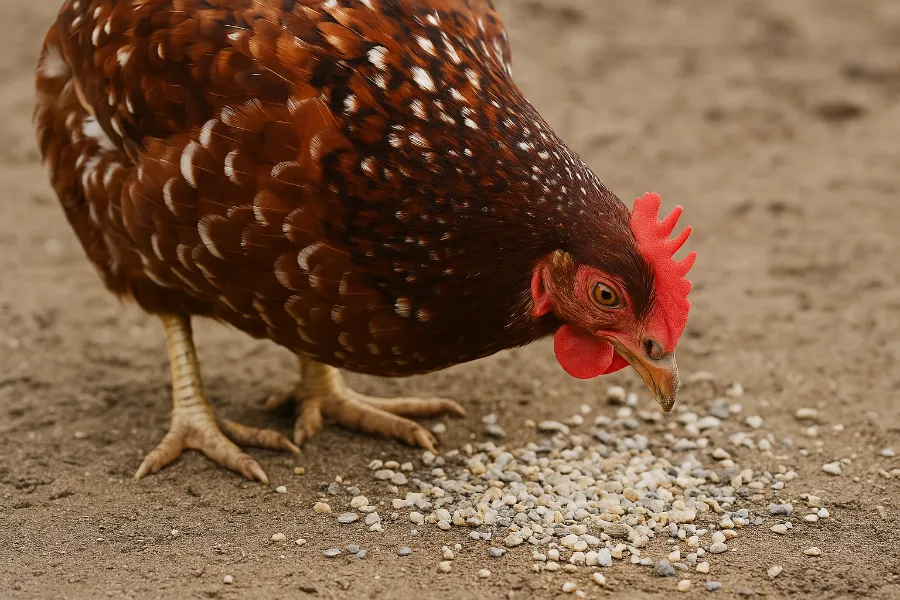
Raising backyard chickens means balancing convenience with care. You might not have acres of pasture, but you can still give your hens a diet that mimics natural variety.
Backyard feeding tips that work:
- Keep feeders small enough to refill every few days — fresh feed smells better.
- Grow greens like kale or spinach near the coop for daily snacks.
- Toss in mealworms or grubs occasionally for extra protein.
- Limit kitchen scraps and carbs — too many can offset the balance of your feed.
- Always, always provide fresh water.
Happy backyard hens aren’t picky — they just need consistency. Feed them well, and they’ll fill your fridge with eggs all year.
Scratch Grains
Let’s talk about scratch grains — the chicken equivalent of dessert.
Scratch is usually a mix of cracked corn, wheat, and barley. My hens love it, but I treat it like candy: fun, but not the main meal.
Feed too much scratch and you’ll dilute protein levels from the layer feed. Egg size, shell quality, and laying frequency will drop.
Here’s my rule: no more than a handful per bird per day, and never before their main feed. I toss it out an hour before dusk they scratch happily, fill their crops, and head to bed satisfied.
Grit for Chickens
If I could give new keepers one underrated tip, it would be this: always provide grit for chickens.
Hens don’t have teeth, so they rely on grit — tiny stones stored in the gizzard — to grind feed into digestible bits. Without grit, even the best feed passes through partially undigested.
There are two kinds:
- Insoluble grit (granite): Aids digestion.
- Soluble grit (oyster shell): Provides calcium for eggs.
I keep both available in small cups inside the coop. Free-ranging birds usually find grit naturally, but confined flocks rely on us to provide it. You’ll notice smoother digestion, healthier droppings, and stronger shells.
Feed Storage Bins
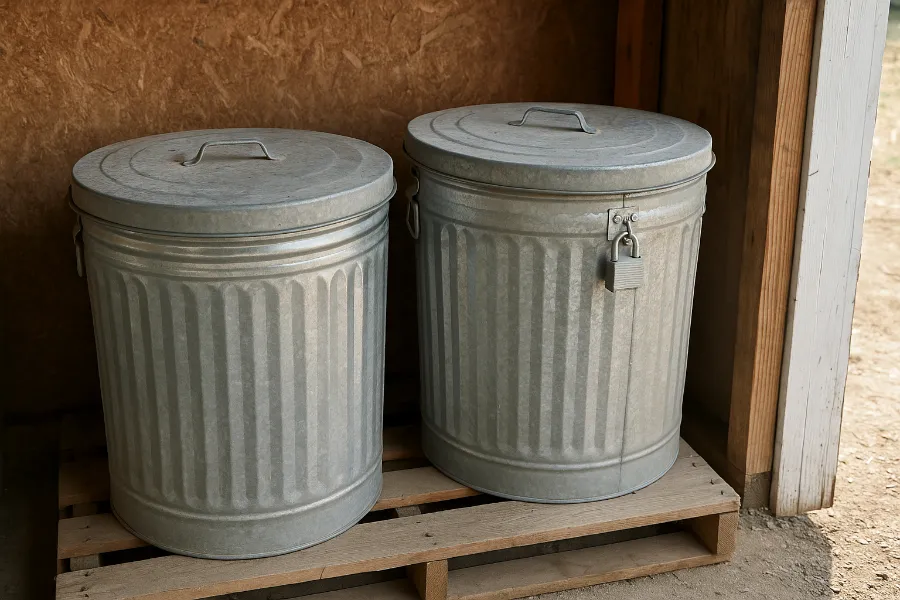
I learned this lesson the hard way — twice. First, mice got into my feed. Then humidity ruined an entire 50-lb bag. Now, feed storage bins are non-negotiable.
How I store feed safely:
- Airtight metal bins with locking lids
- Off the floor, in a dry, shaded shed
- New bags go on the bottom (first in, first out)
- Never mix old and new feed together
A clean, sealed bin keeps out rodents, insects, and moisture. It also prevents mold growth, which can quietly harm hens and reduce egg flavor.
Feed is an investment — treat it like one.
Automatic Chicken Feeder
Modern convenience meets coop life: the automatic chicken feeder.
I switched to a treadle feeder two winters ago, and I’ll never go back. It opens only when hens step on it, which means zero feed loss to sparrows or rats.
Why I recommend automatic feeders:
- Keep feed clean and dry
- Reduce daily chores
- Prevent waste
- Ideal for vacations or long workdays
There are also gravity feeders (great for smaller flocks) and programmable timed feeders (perfect for larger coops). Pair one with an automatic waterer, and you can go away for a weekend knowing everyone’s fed.
Poultry Feed Calculator
I used to guess how much feed to buy each month. Then I found a poultry feed calculator, and suddenly my numbers made sense.
Here’s an example from my flock:
- 10 hens × 0.3 lb feed per day = 3 lb/day
- 3 lb/day × 30 days = 90 lb per month
That means roughly two 50-lb bags per month. Using a calculator helps you plan purchases, budget accurately, and avoid wasted or expired feed.
Over time, I noticed my flock’s appetite changes with the seasons — they eat more in cold months, less when foraging in summer. Tracking feed helps me adjust quickly.
My Feed Routine (and What Actually Works)
I’ve tried fancy organic feeds, homemade mixes, and fermented grains. What finally worked was simplicity:
- Morning: Fill automatic feeder with 16% layer pellets.
- Afternoon: Let hens free-range for bugs and greens.
- Evening: Toss a handful of scratch per bird for enrichment.
- Always available: Grit, oyster shell, and clean water.
The result? Healthy hens, bright combs, steady egg production, and minimal waste.
It’s tempting to overcomplicate feeding, but trust me — hens thrive on routine more than novelty.
Final Thoughts on Chicken Feed
If there’s one thing years of raising hens have taught me, it’s that chicken feed is more than a daily chore — it’s a relationship between nutrition and nature.
Feed them well, and they’ll return the favor in golden-yolked eggs and cheerful clucks each morning.
No matter your setup — a small backyard flock or a barn full of layers — invest in good feed, proper storage, and consistent routines. Use a poultry feed calculator to stay efficient, an automatic feeder for convenience, and never skip grit or oyster shell.
Your hens don’t need perfection. They just need care, consistency, and a keeper who knows that every scoop of feed builds tomorrow’s egg.
FAQs
A laying hen typically eats about 4–6 ounces of chicken feed daily, depending on her breed, size, and activity level. Free-ranging hens may eat slightly less since they supplement with natural foraging.
Choose a complete layer feed with 16–18% protein and added calcium for strong shells. Pellets or crumbles are both great choices for steady egg production.
Yes, but it requires careful balancing of protein, calcium, and vitamins. If you’re new to mixing feed, start with a commercial base and gradually add natural grains or supplements.
Keep feed available at all times through a feeder, and refill it daily. Chickens eat small, frequent meals throughout the day, so consistent access helps maintain egg production.
Grit helps chickens grind their food in the gizzard since they don’t have teeth. Always offer grit (and oyster shell) free-choice to support digestion and strong eggshells.
Use airtight feed storage bins to keep feed dry and pest-free. Store in a cool, shaded area and rotate old stock first to maintain freshness.
A poultry feed calculator estimates how much feed your flock needs per month. It helps you budget, reduce waste, and ensure every hen gets enough nutrition for steady laying.

